Salvaging the Triplane
In order for British aircraft designers fully to understand the capabilities of and technical innovations in German aircraft, an evaluation unit had been established. Under this scheme, all downed German aircraft fell under the jurisdiction of the Royal Flying Corps, and after 1 April 1918, the Royal Air Force. Each Wing had a salvage crew which would proceed to the site, dismantle the aeroplane (providing it wasn’t just a heap of burnt wood and metal) and take it to a designated aerodrome where it would be examined, and if required, and still in flying condition, shipped to England for performance evaluation. The same organisation also retrieved all force-landed British aircraft and inspected those seriously damaged in battle or for any other reason.(l)
Between 1100 and 1200 hours on 21 April, as the Camels of 209 Squadron landed back at Bertangles, they were carefully examined for combat damage. 1st Air Mechanic Boxall- Chapman, the 3 AFC Squadron airman who would soon be ordered to go to the crash-site of Richthofens Triplane, was examining May’s Camel D3326 which had sustained an unusually large number of bullet holes. If any main structural member had been damaged, it would need to be returned to the Central Workshops at the Aircraft Repair Depot (ARD) near Amiens. However, the Camel had evidently only suffered fabric damage, which would be quick and easy to repair as it was used by him the following day for the morning patrol.
Towards the end of his examination, Boxall- Chapman received a summons to return to Poulainville aerodrome, which was close-by, to join Warneford’s salvage party, which was preparing to depart to retrieve the downed Fokker.
Before he arrived there, Lieutenant Donald L Fraser, the intelligence officer of the 11th Infantry
(l)The British authorities did not realise some of the true potential of German aircraft until after the war. For instance the synthetic petrol used by the Germans had a fir higher octane value than the petrol issued for British aircraft, which gave them a better rate of climb. All tests in England, of course, were conducted using standard British aircraft petrol.
Brigade, assisted by Corporal Norman Ramsden, Corporal J Homewood and Private Frank Wormald. had removed von Richthofen’s body from the cockpit and placed it on the ground nearby. It lay there until removed by the salvage crew. Private Emery obtained a neat pair of Zeiss binoculars which had been about his neck, while Private Jeffrey acquired a short-barrelled 9 mm German officer pilot’s Luger pistol.
Major Beavis, having sent the battery’s folding stretcher to Sainte Colette, later recalled receiving the body back at his dug-out. He reported the crash, and that he was holding the body, at his HQ the 14th Artillery Brigade. When Lieutenant Warneford of 3 AFC arrived with the salvage party, he told Beavis that Richthofen had been shot down by an RES of their Squadron, which Beavis thought was ‘… ridiculous.’
The following description is taken word for word from a letter written by Boxall-Chapman on 28 May 1936, which the authors consider more accurate than accounts written by him 25 years later and which, prior to publication, may have been edited. In the letter he mentions the encounter between May, von Richthofen and Brown, but this can only be hearsay. The salvage crew consisted of Warneford. Sergeant Richard Foales, and airmen J К Kitts, Joseph Waldron, Colin Collins and Boxall-Chapman. Boxall – Chapman, who lived in Lincoln in 1936, recorded in a letter to John Column:
___ six of us set off to the scene
of the crash in broad daylight, as it was thought that the pilot may still be alive (we usually salvaged planes at night as ‘Jerry* had a habit of strafing the crash).
We arrived at the battery, climbed the hill and went forward about У< mile when the plane came into view, and low and behold it was a red Triplane, the Red Devil. We now knew the reason for the daylight job. ‘Jerry’ was not shelling it.
Now picture the scene; on our right the Battery, on our left a destroyed sugar factory [1], in front a red plane stuck into the end of a
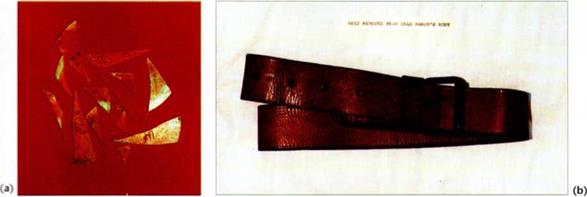
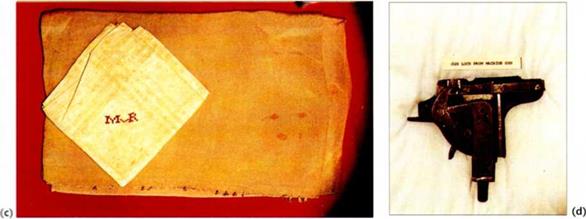
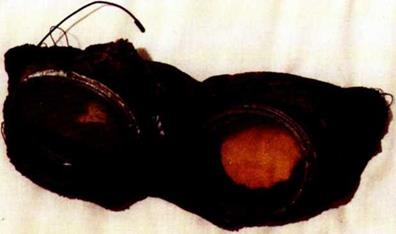
![]()
(a) yellow glass from one lens, broken some years later.
(b) von Richthofen’s leather belt.
(c) von Richthofen’s handkerchief – note initials – and scarf.
—————– :————-
(d) breech block from von Richthofen’s right – hand gun, No.1795.
(e) von Richthofen’s flying goggles.
‘potato pie’ [2] (potatoes piled up and covered with earth), an occasional shell flying well over our heads, and now and then one searching for the Battery, with a shell on bursting smelling of pineapples (gas).
About Уг a mile further in front was our trenches [3] with ‘Jerry’ immediately in front again, and we could plainly see the smoke of discharge of the German artillery, so you can see the plane was an easy mark if he cared to shell it, but never a shot was fired at it.
We halted about Y* mile from the plane and myself and another [Private Collins] went forward. We walked about 200 yards and then started to crawl the remainder. When we arrived at the plane we first examined the pilot’s identification disc, it was the Red Devil.
We noticed he had a dark ring round his neck [4] (broken neck) and a cut on his forehead. The force of the crash threw him on to his guns which cut his forehead and broke his neck. There was blood on his right side and so we traced the bullet hole, there was one in the right side of the cockpit (standing at tail and looking forward) but none on the other side, so I traced the track of the bullet; it entered half way down his right side, passed upwa-rds and outwards, coming out behind his left shoulder. (No bullet fired from the air could have travelled in this di recti on.)
We then tried to remove the body, but found it too heavy for us so we decided to get a rope. My companion returned to the party for a rope, and whilst he was away I made an examination of the plane. I noticed that the ignition switch [5] was in the off position: this fact puzzled me until I read his book, wherein he states that he always switches off his engine when in trouble (a very wise precaution to prevent fire if the plane should crash). There was ample petrol in his tank. I next examined his guns, these were twin Spandaus [6]. mounted together, there was ample ammunition; but opening the breech of the first gun, I found what I took to be a discharged shell [7]. stuck in the chamber: the second gun was exactly the same (when our armourers stripped the guns after the machine had been salved it was found that both cartridges had been struck and failed to explode); this is the most difficult if not impossible stoppage to clear in the air [8]; from examination of the cartridges later it was evident that he had attempted to clear his guns by cocking and firing, but without success, and very fortunate for May.
The propeller was smashed [9]. so was the three right-hand planes and undercarriage but the three left-hand planes were intact [10].
When my companion returned with the rope it was fastened under his armpits [11] and with the assistance of the whole party, the body was drawn back. It was then placed upon a stretcher and carried back to the Battery and laid under the protection of the cliff face. We then returned to the plane, and by placing a false undercarriage under it we were able to draw it back to the trailer, on which we loaded it and returned to camp [12]. I never saw the body again out of its coffin.
It was getting dark when we arrived back in camp, and further examination of the plane was impossible; a guard was placed on it, but when I returned to complete my examination in the morning there was nothing left except the bare spars, even the guns had been removed by souvenir hunters [13], but I was fortunate to get both cartridges out of the guns, one of which I gave to the CO, the other I still have.
This is a faithful picture as I saw it. could I have found my diary I would have been able to give the names of the party that was with me.
Notes: 111 The factory actually made bricks, not sugar.
|2| The ‘pie’ was composed of sugar beets, not potatoes. As the Triplane was now touching the ‘pie’, it seems that an attempt had already been made to move it. or at least turn it around.
[3| The trenches were some short French ones made a year or more earlier. They did not form a line. On that part of the front, the River Somme and the cover provided by the Morlancourt Ridge obviated the need for continuous static defences. [4| The dark ring most likely came from the grease soaked into the collar of von Richthofens flying suit and would appear to have been washed off during the preparations for the official medical examination. To avoid frostbite, airmen put a thick layer of grease over the exposed skin. With constant head turning, it would spread around. Von Richthofens neck was not broken.
[5] The 110-lip LeRhone rotary engine, from which the 110-hp Oberursel was copied, had only one magneto. Many publications have ‘corrected’ Boxall-Chapman’s word ‘magneto’ to “magnetos’ which raises the question of the value of editing a witness’s words.
|6] Spandau is the name of the city where the German machine-gun factories were located. The type of gun used on the Fokker I)r. I was a belt – fed Maxim adapted for air-cooling and known as the LMG 08/15. LMG (Luftgekiihlte Maschinen Gewehr. type 8, designed in 1915.)
The word ‘shell’ refers to a cartridge. Boxall- Chapinan’s reference to the ample supply of ammunition remaining tallies with witnesses who said the Triplane pilot was firing very short bursts or none at all. as opposed to those who stated the German pilot was ‘blazing away with both guns.’ [8] To clear this fault the defective cartridge needed to be removed from the breech without the belt slipping. The vibration of the engine virtually guaranteed slippage. Ground-based Vickers gun crews considered the correction to be a two-man operation.
14 The propeller was actually broken, not smashed. One blade had snapped off. Captain LeBoutillier’s mechanics unbolted the propeller remains from the engine and carved a walking stick for Boots.
[ 10] The left and right in the letter are based upon the viewer looking at the Triplane from the front, which is how Boxall-Chapman would have seen it as he approached Sainte Colette from the 53rd Battery. In later letters, he was more precise. As seen from the pilot’s seat, the port (left) wings were the damaged ones.
[ 11 j Some people have stated that the rope was attached to von Richthofen’s parachute harness. Boxall-Chapman, being the man who tied the rope, should have the best recollection.
12] Some people have stated that the Triplane was dragged back across the held by a rope. This would be virtually impossible to do as protruding broken pieces would dig into the ground, which in itself wasn’t smooth. The late Cole Palen, who more than once had to remove a similarly damaged replica Dr. l from Old Rhinebeck airfield in a hum. told the authors that the Dr. l was not heavy; it was awkward. Ten men could pick it and carry it easily. With a dolly beneath it (a false undercarriage) and a rope attached to the dolly, only one man would be required to steady the starboard (right) wings whilst the others, from a sheltered position tugged the rope.
113] The two machine guns were recovered and are to be seen in photographs taken on the morning of the 22nd. They both disappeared again shortly afterwards.
John Coltman replied to Boxall-Chapman and asked a few additional questions to which the latter replied in June 1936:
From my examination of the machine and enquiries made. I would say that the machine made a good landing considering there was a dead pilot on board. The idea of the plane being pulled back gently by a rope is ‘rubbish*. The body was pulled back by a rope as I stated in my previous letter.
On 29 January 1918. Leutnant Eberhard Stapenhorst of Jasta 11 had force-landed his Fokker Dr. l (144/17: RAF ‘G’ No. 125) inside British lines and had been unable to destroy it. The machine, which was only slightly damaged, was repaired and extensively test-flown. There was no need for another one, therefore Richthofen’s 425/17 held no particular interest. For this reason no serious action was taken to prevent extensive souveniring whilst the Triplane was at Sainte Colette waiting to be loaded onto a trailer, nor later at Poulainville.
The missing fabric and instruments (it looked as though rats had been at it) had to be explained somehow to HQ, so the time of the ‘Evening Hate’ was advanced to suit and the ‘damage’, while at Sainte Colette, attributed to that. A ‘box barrage of fire by the Germans to allow the pilot to escape’ was invented by others which was illogical as, given the inaccuracy of the badly worn barrels of most German guns, they were more likely to kill him than save him. The special outer clothing worn by airmen precluded long distance running and two miles was a bit far for von Richthofen to travel through enemy-held territory dressed solely in his pyjamas, which were the only clothing he was wearing beneath his flying gear.
Private Emery, the AA machine gunner nearby, confirmed that the Germans did not aim a barrage at the downed fighter, although several stray shots intended for other targets landed nearby.
At Poulainville, the remains of the Triplane
Right: Control column from Richthofen’s Triplane. Top left are the two recangular gun triggers marked L & R. On top is the coupe button for the magneto; on the right is the finger grip and on the left is the auxiliary throttle control. The holes at the base are for the cables from the throttle and triggers.
were filmed on the morning of the 22nd by The Army Film Unit and used in a newsreel. The written narrative was translated into French and Portuguese (and perhaps other languages). Half a dozen ‘still’ photographs were also taken. The photography clearly shows that there are no bullet holes in the elevators or the top of the fuselage behind the cockpit. The fabric from the rudder (both sides) had been ‘liberated’ by this time but the owner of one side (originally in the possession of Captain Brown) assured the present authors that there are no bullet holes through it. Diving on the Triplane at 190 mph. which itself was travelling at about 110 mph. Brown was closing at around SO mph (ie. about 40 yards per second). During his long burst of fire – recorded as five to seven seconds – he would have reduced the distance between the two aircraft by approximately 240 yards. Which means he must have opened fire at about 3(H) yards, and ceased at 50.
To test the theory of Brown having seen his bullets striking the Triplane (see Appendix E), the authors set up a red-painted piece of plywood, with holes drilled in it to represent.303 bullet strikes. As opposed to the actual event, the experiment was under ideal conditions; there was no aircraft ‘shake or vibration’ causing problems at either end, ie: the piece of plywood was stationary. The sun was positioned behind the viewer and shining on the plywood.
By using accurate measured distances with a 100 foot tape measure, it was found that beyond 60 yards the bullet holes could not be seen! This clearly establishes that the story given that Brown, who commenced firing at long distance, saw his bullets striking the Triplane’s tailplane and then corrected his aim, is pure fabrication.
Similarly, von Richthofen’s head turning to see who was attacking him, is equally disproved, for at a distance of over 100 yards, a dark helmeted head half buried in a cockpit with face covered by goggles and muffled against frost bite, cannot be seen to turn.

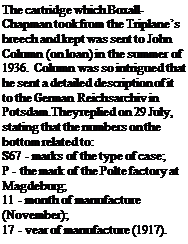

![]() The many journalistic renderings in post-war pulp magazines and the like where various lines of bullet holes were ‘stitched’ across the tail, up the fuselage decking and into the pilot’s back, are
The many journalistic renderings in post-war pulp magazines and the like where various lines of bullet holes were ‘stitched’ across the tail, up the fuselage decking and into the pilot’s back, are
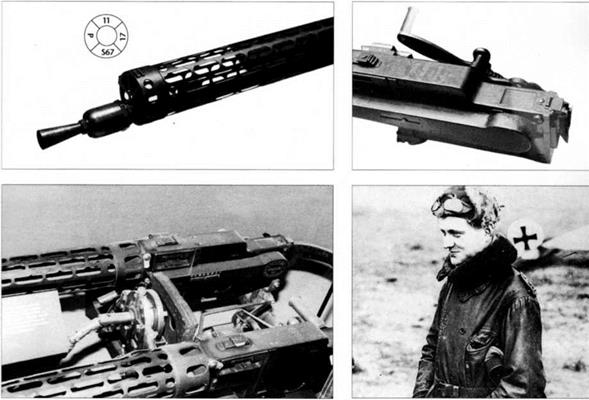
Top left: Detail of the muzzle of an LMG gun showing the air cooling jacket, recoil booster and the flash suppressor.
(Inset: sketch of the base of the cartridge from the Triplane’s gun.)
Top right: Detail of the LMG gun showing the cocking handle.
Above left: Twin LMG 08/15 (Made in Spandau). The cable of the synchronising mechanism can be seen between them.
Above right: Von Richthofen with the flying goggles he normally wore but they were not the ones he used on the fateful day.
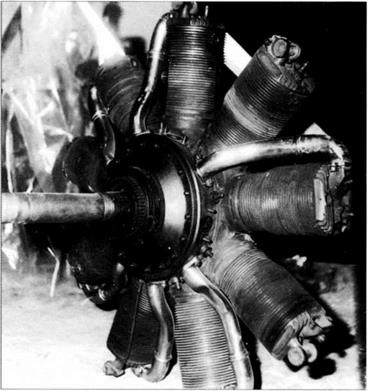 RiCHT:The Triplane’s engine showing no damage to the cylinder-heads indicating that the engine had stopped prior to the crash-landing. Viewed from the rear. Those heads that are not visible in this picture can be viewed in the colour picture earlier (page 9).
RiCHT:The Triplane’s engine showing no damage to the cylinder-heads indicating that the engine had stopped prior to the crash-landing. Viewed from the rear. Those heads that are not visible in this picture can be viewed in the colour picture earlier (page 9).
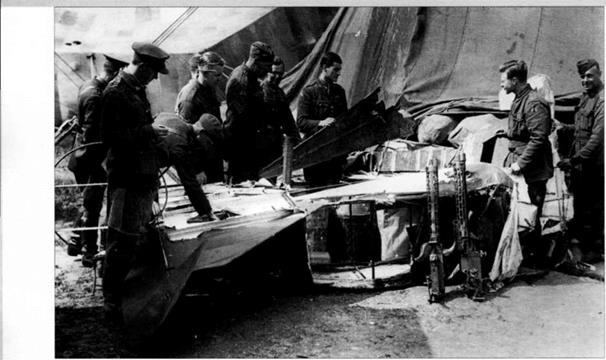 |
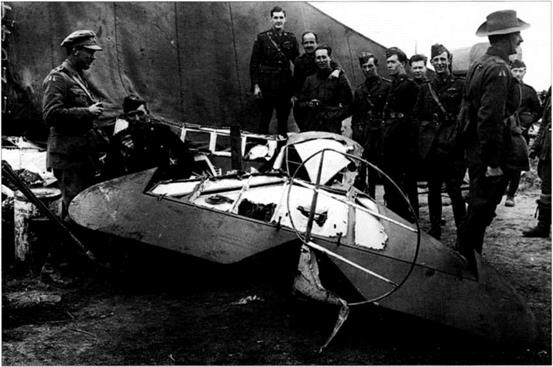 |
Two well known photos of the ‘well-souvenired’ Triplane at Poulainville aerodrome, surrounded by men of 3 Squadron AFC. Of interest is the complete lack of bullet holes in the elevators and the fuselage decking behind the cockpit, despite the damage sustained by the souvenir hunters.
In the lower picture the officers are: (left to right) Lts C W Cray, F J Mart, N Mulroney, A V Brown,
T L Baillieu, R W Kirkwood, A L D Taylor, A E Crigson, M Sheehan, – guard










